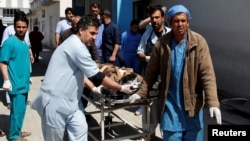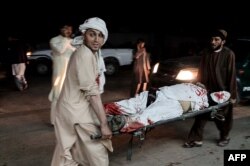Violence across Afghanistan killed 121 civilians and injured 322 others in March, according to a Civilian Protection Advocacy Group (CPAG) report.
The deadliest attack was on March 21, when a suicide bomber targeted civilians returning from a New Year celebration in the Kart-i-Sakhi area of Kabul. At least 33 people were killed and 65 injured in that attack, according to Afghan officials.
Islamic State claimed responsibility for the attack.
Another suicide attack killed at least 14 and wounded 42 at a sports event in Lashkar Ghah the capital city of southern Helmand province, on March 23.
No group has claimed responsibility for that attack.
CPAG also blamed the Afghan national security and defense forces (ANDSF) for the death of at least eight civilians during a military operation in Chaprahar district of eastern Nangarhar province, on March 17.
Security challenges
The Afghan government says it has developed strict guidelines for the protection of civilians during military operations. But casualties as a result of suicide bombings and other acts of terrorism are a more difficult challenge.
“More civilians are killed during attacks carried out by terrorist groups; the victims of recent attacks in Kabul, Helmand, and Nangarhar are all civilians. Shah Hussain Murtazawi, a spokesperson for the Afghan president told VOA.
“[The] Afghan government has given clear guidance to ANDSF to use all means to prevent civilian casualties,” he added.
Some blame the problem on leadership.
“Unfortunately, there will be both civilian and military casualties unless the government resolves the existing problems at the leadership level,” Afghan army retired Lt. General Gul Nabi Ahmadzai told VOA.
“Our soldiers are fighting with the spirit of patriotism, however, there is a lack of management at the leadership levels - the forces are not used in a proper manner to defeat the enemy, thus more casualties are expected, unfortunately,” he added.
More than 10,00 deaths in 2017
The Office of the United Nation High Commissioner for Human Rights (OHCHR) recently reported that despite a 10 percent decrease, the civilian casualties, including both deaths and injuries, in Afghanistan still exceeded 10,000 in 2017.
The report attributed 65 percent of the casualties to anti-government elements and 20 percent to pro-government forces.
A report by United Nation Assistance Mission (UNAMA) in Afghanistan, released in February, attributed 42 percent of casualties to the Taliban, 16 percent to the Afghan government, 10 percent to the Islamic state, and the rest to unknown anti-government elements.










